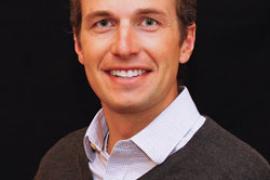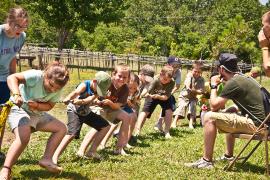This article is part of Camping Magazine’s series on inclusion, identifying and exploring both big picture and on-the-ground actionable pathways for application through participant reflection, discussion, and active engagement. Contact Niambi Jaha-Echols ([email protected]) if you would like to participate or contribute to this series.
Every year, American Camp Association (ACA) camps provide millions of young people with transformative — even life-changing — experiences. From building new friendships to gaining new life skills, we know that the impact of these experiences on young people’s lives and our broader culture should not be underestimated.
Looking at the challenges we face today, it isn’t hard to see that the world could use more of what makes camp so special. So, how can camps build off the powerful track record of positive impact at camp and use it to drive even more change in wider society?
The first and most obvious place to start is expanding access to the camp experience. According to the US Census Bureau, 18 percent of children in our country live under the poverty line. Although we are able to serve many in our programs, we know there are more who can benefit from the camp experience. Given the often-high costs of attending, how do we remove economic and cultural barriers to ensure that all children can benefit from what camp has to offer?
There’s no reason to stop there. From environmental degradation to substance abuse, from homelessness to racial injustice, many issues could do with a touch of good old fashioned “camp magic” to move our society forward. Many camps and camp organizations are already hard at work on cracking this code. But where do we begin?
Where and how can the camp community do more to expand our impact and transform our communities?
Understand Your Purpose
Often, when embarking on a new endeavor or challenge, it can be tempting to jump right into what it is you are trying to achieve. It’s important, however, to first spend some time understanding why you’re doing it. Without understanding your “why,” your “what” may end up being misdirected, or you may miss opportunities that were sitting right under your nose. By understanding your core purpose and what drives your camp culture, you’ll be better placed to find the unique points of leverage where your strengths and assets meet the specific needs of the communities you are looking to support.
Of course, it goes without saying that camps have an innate reason to be. They are safe spaces. They are places where campers can grow and seek enrichment. And they are a catalyst for youth development, keeping young minds and bodies active during the long school holidays. Knowing the fundamentals of why all camps exist, however, is not enough. To do your best work, it’s important to examine why your camp does the work it does:
- What problems does your camp seek to solve?
- What other factors contribute to those challenges?
- What populations does it serve and what are their specific needs?
- What is unique about your camp and your culture?
- When your camp is at its best, what happens?
- How do you know you’re succeeding in achieving your purpose?
- What results or metrics guide you?
- Who are the stakeholders that your camp should consider in pursuing your purpose?
- Who else affected by the problems or needs you’re addressing could you reach?
The answers to these questions can be invaluable in identifying opportunities for scaling your social impact efforts.
Breaking Down Barriers: Opening Camp to the Local Community
Since 1956, Camp Rockmont for Boys — located in the rural community of Black Mountain, North Carolina — has provided a classic summer camp experience. The camp initially served boys and young men locally, and eventually expanded its reach across the United States and around the world, developing an international reputation for sought-after youth development and boys’ education experiences.
Despite this success, veteran camp director Dan Davis recalls a chance encounter with a young boy that led him to realize how much more work was still to be done.
The young boy — about eight years old — lived in a low-income community that bordered the camp property. He had been riding his bike in and out of camp, looking for a way to spend his time. As Davis approached him — initially to discuss the topic of trespassing — he was struck by another, much more important thought.
“We have found a way to bring young men here from as far away as San Francisco and Barcelona. Yet we don’t engage the kids who are 100 yards away.”
This thought led to a bigger discussion with his leadership team: How does a “storied boys’ camp” begin to break down the walls and tear down the gates? How does it make camp accessible to the children who are idle just down the road from camp? The result of these discussions was a new day camp program designed specifically to serve the children — both boys and girls — in the local community who might otherwise never have had an opportunity to attend a camp like Rockmont.
Davis saw that the kids in the community surrounding camp shared similar needs with the campers they served from all over the world. That understanding helped Camp Rockmont spread its impact in a new way into its surrounding communities.
Camp Doesn’t Have to Be at Camp: Bring the Experience to the People
For 25 years, Camp Twin Lakes has provided fully adaptive, medically supportive, and deeply impactful resident camp experiences to more than 10,000 young people living with serious illness, disabilities, or other life challenges. By creating an appropriate camp environment where children could be around their peers who live with similar challenges, Camp Twin Lakes has created an invaluable opportunity for children who are too often marginalized to experience life in the majority. After spending every other day of the year adapting to the world around them, for one week, camp adapts to them.
However, while the resident camp experience has been vital to those who could attend, the reality is that many other children and young adults who Camp Twin Lakes would like to serve are not able to take time out from medical treatment to attend camp.
So, they decided to take the camp to them with Camp Twin Lakes’ Camp-To-Go program.
Camp-To-Go is grounded in the same mission that Camp Twin Lakes has always pursued, but it rethinks traditional assumptions of what constitutes a “camp location.” By redesigning camp so rounds of archery could be played on hospital floors, camp cheers could fill clinic hallways, and arts and crafts could be completed in the unlikeliest of places, Camp-To-Go has demonstrated that the spirit of camp can make a difference in even the most challenging environments. Campers found that the core parts of their camp experience, like taking time out of the day-to-day to play, to cooperate, to challenge each other and rediscover what it is that makes each of us special, could happen anywhere.
Through deep understanding of their purpose, Camp Twin Lakes recognized that some of the young people they exist to serve couldn’t make it to camp to benefit from their programs. By taking the camp experience to patients, they forged a new way to further their purpose and expand their impact.
Using Camp Expertise to Benefit More than Just Campers
We all know that camps provide practical tools and life skills that are invaluable for individuals of all income levels and demographic backgrounds.
Identifying who else could benefit from the skills that your camp teaches can also be a great way to expand your impact.
For over a hundred years, the YMCA of the Rockies has been providing wilderness experiences and education for campers, as it is bordered on three sides by Rocky Mountain National Park. In assessing their impact, however, staff recognized that their expertise in this area could provide opportunities for economic development in the rural communities surrounding their camp. With limited job opportunities available for their neighbors, the YMCA of the Rockies realized they could help change that by using their knowledge to become a training center offering Wilderness First Aid, Wilderness First Responder, and Avalanche and Winter Safety courses to the local community at discounted rates. With those skills, their neighbors would have access to new opportunities to help visitors take advantage of their local outdoor opportunities safely. Brandon Reynolds, outdoor education director, explains more:
“Many of the people who live here share the passion for the wilderness that we, as a camp, have always celebrated. They want to play their own part in providing visitors an opportunity to enjoy those resources, but in a safe way. By becoming a training center, we can offer skills to the community at a reduced rate. This lowers the economic barriers for accessing such trainings, and it also removes the need to travel. By creating access, we are providing new opportunities to people who might otherwise not be able to benefit.”
The YMCA of the Rockies is just one of the many examples of camps that are leveraging a broader, deeper understanding of their own mission — and a wider sense of who they serve — to scale their impact and expand their reach.
Social Problems to Solve
From addressing literacy deficits to alleviating hunger, from tackling the psychological effects of poverty to building closer communities or increasing job opportunities, the good — and not so good — news is that we are not short of social problems that camps can play a role in solving.
By understanding who you are and why you exist, who you serve and what their needs are, and where the opportunities are in the communities around you, you can create new opportunities that don’t just advance social change — they enhance the experiences of your staff and campers too.
It’s important to recognize, however, that this work takes time. And it’s not easy. But if your efforts are fueled by your camp’s purpose and a desire to explore where else it is needed, then your new initiatives will likely organically complement the work you are already doing. Before you know it, you’ll be fueling change in ways that never occurred to you before embarking on this journey.
Things to ConsiderTo become the camp you wish to be, consider the following:
|
Authors’ note:
Thank you to the following camps and all the camps working to expand their positive impact:
Camp Twin Lakes —
camptwinlakes.org/about-us/camp-to-go/
Camp Rockmont — rockmont.com/
YMCA of the Rockies —
YMCARockies.org
Photo courtesy of Camp DeWolfe, Wading River, New York.
Dan Baum is the chief strategy officer for The Redwoods Group, which uses mission-aligned insurance to create safe communities. He is also the executive director of The Redwoods Group Foundation, which builds off of Redwoods’ impact to catalyze nationwide collective impact movements targeted at the root causes of community safety problems like child sexual abuse.
Katie Johnson has spent 20+ years as a youth development professional working with both resident and day camp programs, including eight years with the American Camp Association. Most recently, Katie joined The Redwoods Group as a consultant where she is sharing her professional experiences to help camps and youth-serving organizations provide safe environments and programs for children and families.


